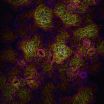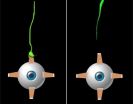(Press-News.org) MINNEAPOLIS – Older people who have apathy but not depression may have smaller brain volumes than those without apathy, according to a new study published in the April 16, 2014, online issue of Neurology®, the medical journal of the American Academy of Neurology. Apathy is a lack of interest or emotion.
"Just as signs of memory loss may signal brain changes related to brain disease, apathy may indicate underlying changes," said Lenore J. Launer, PhD, with the National Institute on Aging at the National Institutes of Health (NIH) in Bethesda, MD, and a member of the American Academy of Neurology. "Apathy symptoms are common in older people without dementia. And the fact that participants in our study had apathy without depression should turn our attention to how apathy alone could indicate brain disease."
Launer's team used brain volume as a measure of accelerated brain aging. Brain volume losses occur during normal aging, but in this study, larger amounts of brain volume loss could indicate brain diseases.
For the study, 4,354 people without dementia and with an average age of 76 underwent an MRI scan. They were also asked questions that measure apathy symptoms, which include lack of interest, lack of emotion, dropping activities and interests, preferring to stay at home and having a lack of energy.
The study found that people with two or more apathy symptoms had 1.4 percent smaller gray matter volume and 1.6 percent less white matter volume compared to those who had less than two symptoms of apathy. Excluding people with depression symptoms did not change the results.
Gray matter is where learning takes place and memories are stored in the brain. White matter acts as the communication cables that connect different parts of the brain.
"If these findings are confirmed, identifying people with apathy earlier may be one way to target an at-risk group," Launer said.
INFORMATION:
The study was supported by the National Institutes of Health, the National Institute on Aging, the
Icelandic Heart Association and the Icelandic Parliament.
To learn more about dementia, please visit http://www.aan.com/patients.
The American Academy of Neurology, an association of more than 27,000 neurologists and neuroscience professionals, is dedicated to promoting the highest quality patient-centered neurologic care. A neurologist is a doctor with specialized training in diagnosing, treating and managing disorders of the brain and nervous system such as Alzheimer's disease, stroke, migraine, multiple sclerosis, brain injury, Parkinson's disease and epilepsy.
For more information about the American Academy of Neurology, visit http://www.aan.com or find us on Facebook, Twitter, Google+ and YouTube.
Media Contacts:
Rachel Seroka, rseroka@aan.com, (612) 928-6129
Michelle Uher, muher@aan.com, (612) 928-6120
In old age, lack of emotion and interest may signal your brain is shrinking
2014-04-16
ELSE PRESS RELEASES FROM THIS DATE:
Dermatologists with access to sample drugs write costlier prescriptions, Stanford study finds
2014-04-16
STANFORD, Calif. — Dermatologists with access to free drug samples are more likely than those without access to samples to write prescriptions for drugs that are more expensive, according to a study by researchers at the Stanford University School of Medicine.
Although studies have shown that most physicians do not believe that the availability of free samples affects their behavior or recommendations for patients, the researchers found that the average retail cost of the prescriptions written by dermatologists with access to samples are about twice the cost of prescriptions ...
Free drug samples can change prescribing habits of dermatologists
2014-04-16
The availability of free medication samples in dermatology offices appears to change prescribing practices for acne, a common condition for which free samples are often available.
Free drug samples provided by pharmaceutical companies are widely available in dermatology practices.
The authors investigated prescribing practices for acne vulgaris and rosacea. Data for the study were obtained from a nationally representative sample of dermatologists in the National Disease and Therapeutic Index (NDTI), a survey of office-based U.S. physicians, and from an academic medical ...
Atypical brain connectivity associated with autism spectrum disorder
2014-04-16
Autism spectrum disorder (ASD) in adolescents appears to be associated with atypical connectivity in the brain involving the systems that help people infer what others are thinking and understand the meaning of others' actions and emotions.
The ability to navigate and thrive in complex social systems is commonly impaired in ASD, a neurodevelopmental disorder affecting as many as 1 in 88 children.
The authors used functional magnetic resonance imaging to investigate connectivity in two brain networks involved in social processing: theory of mind (ToM, otherwise known ...
For cells, internal stress leads to unique shapes
2014-04-16
From far away, the top of a leaf looks like one seamless surface; however, up close, that smooth exterior is actually made up of a patchwork of cells in a variety of shapes and sizes. Interested in how these cells individually take on their own unique forms, Caltech biologist Elliot Meyerowitz, postdoctoral scholar Arun Sampathkumar, and colleagues sought to pinpoint the shape-controlling factors in pavement cells, which are puzzle-piece-shaped epithelial cells found on the leaves of flowering plants. They found that these unusual shapes were the cell's response to mechanical ...
Researchers track down cause of eye mobility disorder
2014-04-16
Imagine you cannot move your eyes up, and you cannot lift your upper eyelid. You walk through life with your head tilted upward so that your eyes look straight when they are rolled down in the eye socket. Obviously, such a condition should be corrected to allow people a normal position of their head. In order to correct this condition, one would need to understand why this happens.
In a paper published in the April 16 print issue of the journal Neuron, University of Iowa researchers Bernd Fritzsch and Jeremy Duncan and their colleagues at Harvard Medical School, along ...
Scientists observe quantum superconductor-metal transition and superconducting glass
2014-04-16
The article "Collapse of superconductivity in a hybrid tin–grapheme Josephson junction array'" (authors: Zheng Han, Adrien Allain, Hadi Arjmandi-Tash,Konstantin Tikhonov, Mikhail Feigelman, Benjamin Sacépé,Vincent Bouchiat, published in Nature Physics on March 30, 2014, DOI:10.1038/NPHYS2929) presents the results of the first experimental study of the graphene-based quantum phase transition of the "superconductor-to-metal" type, i.e. transformation of the system's ground state from superconducting to metallic, upon changing the electron concentration in graphene sheet.
The ...
Stanford scientists develop 'playbook' for reverse engineering tissue
2014-04-16
STANFORD, Calif. — Consider the marvel of the embryo. It begins as a glob of identical cells that change shape and function as they multiply to become the cells of our lungs, muscles, nerves and all the other specialized tissues of the body.
Now, in a feat of reverse tissue engineering, Stanford University researchers have begun to unravel the complex genetic coding that allows embryonic cells to proliferate and transform into all of the specialized cells that perform myriad biological tasks.
A team of interdisciplinary researchers took lung cells from the embryos of ...
Red moon at night; stargazer's delight
2014-04-16
Monday night's lunar eclipse proved just as delightful as expected to those able to view it. On the East Coast, cloudy skies may have gotten in the way, but at the National Science Foundation's National Optical Astronomy Observatory (NOAO) near Tucson, Ariz., the skies offered impressive viewing, as seen from the pictures provided here.
Nicknamed a "blood moon," this lunar eclipse's color was similar to the majority of lunar eclipses. This has to do with the Earth's atmosphere's propensity for longer-wavelength light (e.g., the reds, oranges and yellows seen in sunrises ...
Information storage for the next generation of plastic computers
2014-04-16
Inexpensive computers, cell phones and other systems that substitute flexible plastic for silicon chips may be one step closer to reality, thanks to research published on April 16 in the journal Nature Communications.
The paper describes a new proposal by University of Iowa researchers and their colleagues at New York University for overcoming a major obstacle to the development of such plastic devices—the large amount of energy required to read stored information.
Although it is relatively cheap and easy to encode information in light for fiber optic transmission, ...
Two new species of yellow-shouldered bats endemic to the Neotropics
2014-04-16
Lying forgotten in museum collections two new species of yellow-shouldered bats have been unearthed by scientists at the American Museum of New York and The Field Museum of Natural History and described in the open access journal ZooKeys. These two new additions to the genus Sturnira are part of a recent discovery of three bats hidden away in collections around the world, the third one still waiting to be officially announced.
Up until recently the genus Sturnira was believed to contain only 14 species. In the last years closer morphological and molecular analysis have ...



